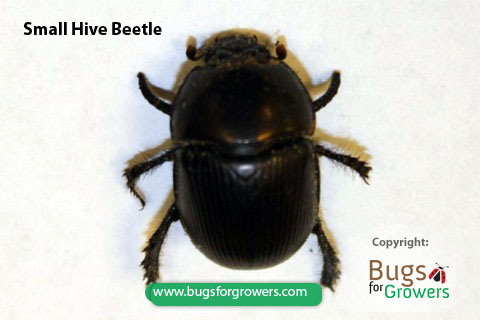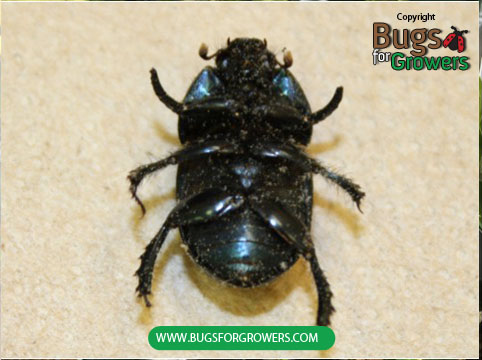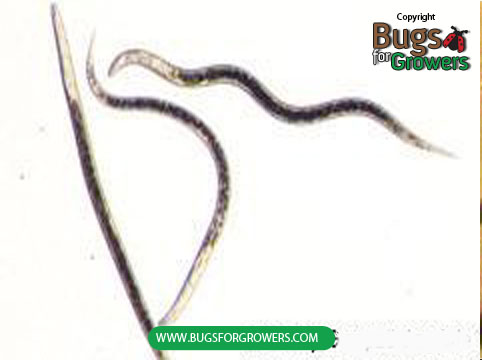What are small hive beetles (SHB)?
Watch following YouTube video to learn about the biology/ life cycle of small hive beetles.
Small hive beetles (Aethina tumida) are one of the most economically damaging insect pests of honeybees in the United States and they are known to cause significant economic losses to beekeepers. Adults of SHB are dark brown to black in color, oval- shaped, about 3- 6 mm long beetles (Photo 1) with club- shaped antennae (Photo 2). Eggs of small hive beetles are elongate and whitish in color. Both larvae (grubs) and pupae of small hive beetles are creamy and whitish in color.


Damage caused by SHB to beehives
Both adults and larvae of small hive beetles cause direct and indirect damage to honeybees. In case of direct damage, both adults and larvae feed on the food resources (stored pollen and honey) of honeybees and their brood. While searching for pollen and honey, both adult beetles and larvae also damage combs and kill brood. In case of indirect damage, both adults and larvae of SHB also disseminate spores of a yeast (Kodamaea ohmeri) into the colony where they grow on honeycomb and cause fermentation of honey. Thus both direct and indirect damages cause the honey to run out of the combs that in turn causes rapid collapse of the bee colony. Fermented honey is also useless as food for both brood and humans.
How to target first and subsequent generations of SHB larvae and pupae with Heteorhabditis indica nematodes?
Technically beneficial entomopathogenic Heterorhabditis indica nematodes (Photo 3) have been used to kill only mature larvae and pupae of SHB because both of these stages are found only in the soil as opposed to young larval and adult stages that live in the beehives (see below life cycle of SHBs) and cannot come in contact with nematodes that are generally applied to the soil and not in the beehives. Also, Heterorhabditis indica nematodes cannot infect and kill SHB adults even though they are exposed to nematodes while living in soil for a short period of time after emerging from pupae and before moving into beehives.
In order to apply indica nematodes at the appropriate time to target both mature larvae and pupae, it is important to learn the life cycle of SHB.

Life cycle of small hive beetles
Small hive beetles generally overwinter as adults with the cluster of bees in the hives. These overwintering adults generally become active and mate when temperature warms up early in the spring usually in April. Mated females then lay clusters of eggs in the cracks, crevices and brood combs in a beehive. Eggs hatch into small larvae within 2- 3 days. These larvae immediately start feeding on pollen, honey and broods, and mature within 10- 15 days.
This means that the first generation mature larvae are now ready for pupation but they cannot pupate inside beehives and therefore, they have to move out of beehives. Therefore, in the middle of April, mature larvae begin leaving the beehives and then burrowing into the soil within 3 feet radius of hives and pupates. Then SHB adults emerge from pupae within 3-4 weeks and move into beehives where they mate and start laying eggs. These eggs hatch into second generation larvae and life cycle continues. When the temperature is warm, SHB can complete 4-5 overlapping generations between April and December.
This suggests that April is the best month for the application of beneficial entomopathogenic Heterorhabditis indica nematodes in the soil to target first generation mature larvae and newly formed pupae of SHB.
How do beneficial entomopathogenic Heterorhabditis indica nematodes kill mature larvae and pupae of SHB?
When the infective juveniles of Heterorhabditis indica are applied to the soil surface around 3 feet radius of beehives, they move in the soil to locate larval and/or pupal stages of SHB. Then nematodes enter into their body cavities via natural openings like mouth, anus and spiracles. Once in the body cavity, nematodes release symbiotic bacteria called photorhabdus spp. from their gut in the blood of larvae or pupae of SHB. In the blood, these bacteria multiply quickly and cause septicemia that kills both larvae and pupae usually within 48 h after infection.
Inside the larval or pupal cadavers of SHB, nematodes feed on bacterial soup and complete 3-4 generations within 12 days of infection. When nematodes sense that there is scarcity of food inside the cadavers, they emerge as infective juveniles from cadavers to seek subsequent generation of SHB larvae that have already moved from beehives into soil for pupation. Since beneficial entomopathogenic Heterorhabditis indica nematodes can recycle themselves as long as they find insect hosts in the soil for infection and reproduction, they can search kill overlapping generations of SHB larvae that have moved in the soil for pupation and therefore there no need to reapply nematodes immediately. Thus nematodes will disrupt the life cycle of SHBs by killing their future generations and save the honeybee colonies from collapsing that in turn reduces economic losses to beekeepers.
How to apply Heterorhabditis indica nematodes?
Beneficial entomopathogenic Heterorhabditis indica nematodes are easy to apply. These nematodes are commercially sold either in gel or granular formulations. For application of nematodes around beehives, dissolve these formulations in water. Then apply this nematode suspension as drench to the soil surface around 3 feet radius of beehives using a small water can with a sprinkler head (Photo 4). As nematodes need a film of water for their movement to seek their hosts in the soil, irrigate the nematode treated area immediately so that nematodes will move freely in the soil profile to seek host insects.
How many Heterorhabditis indica nematodes should be applied?
The optimum rate for the effective control of SHB would be about 23,000 infective juveniles of Heterorhabditis indica nematodes per square foot area.

